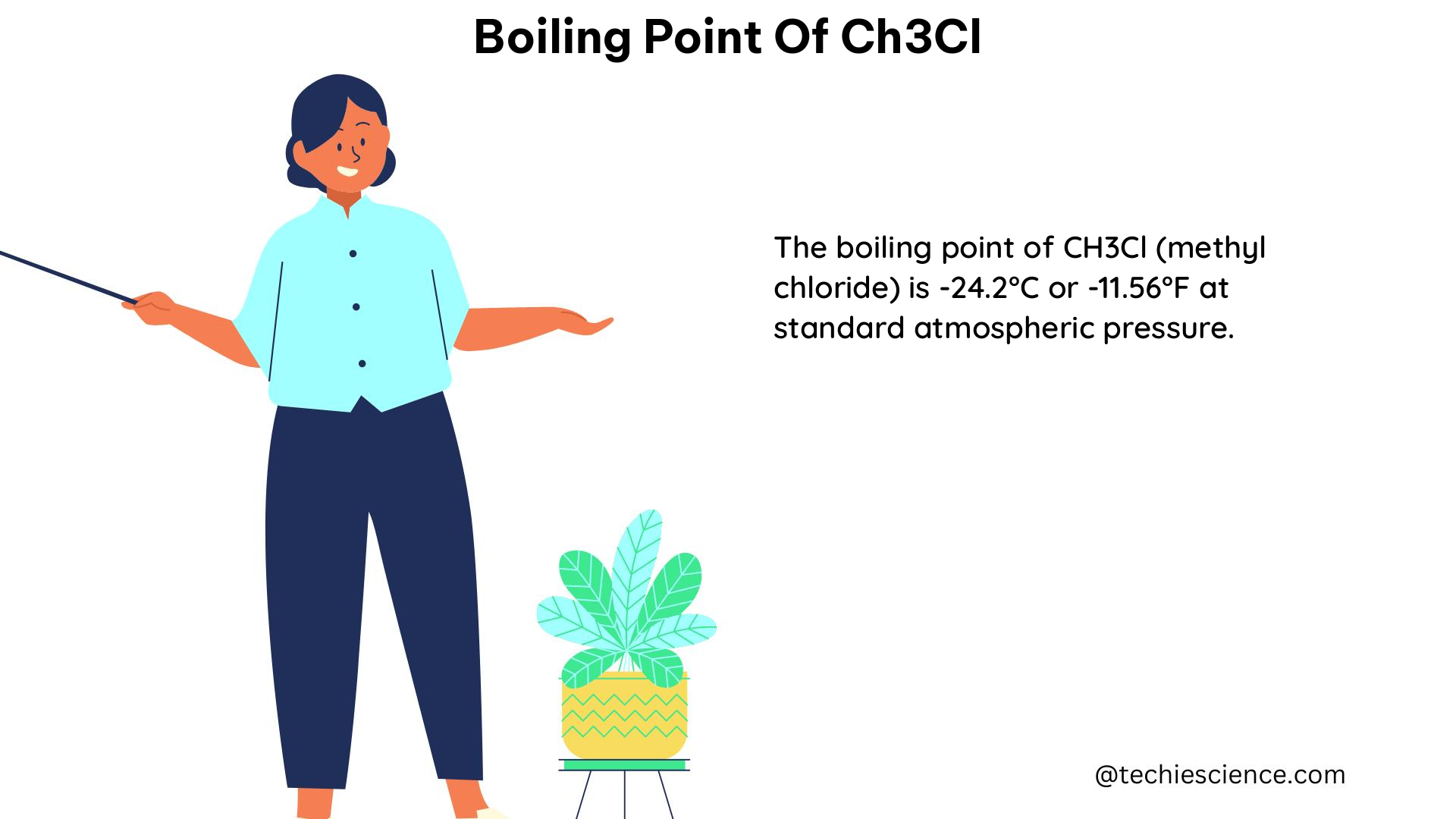The boiling point of CH3Cl (methyl chloride or chloromethane) is a crucial physical property that plays a significant role in various scientific and industrial applications. This comprehensive guide delves into the intricacies of the boiling point of CH3Cl, providing a wealth of technical details and practical insights for science students.
Understanding the Boiling Point of CH3Cl
The boiling point of CH3Cl is approximately -24.09°C (-11.56°F) at a pressure of 760 mmHg. This value is well-documented and consistent across multiple reliable sources, making it a reliable and reproducible physical property.
To understand the significance of this boiling point, it is essential to consider the intermolecular forces at play. CH3Cl, being a polar molecule, exhibits weaker intermolecular forces compared to water (H2O), which has stronger hydrogen bonding. This difference in intermolecular forces is the primary reason why the boiling point of CH3Cl is significantly lower than that of water (100°C or 212°F at 760 mmHg).
Theoretical Explanation
The boiling point of a substance is determined by the balance between the vapor pressure of the liquid and the external pressure acting on the system. According to the Clausius-Clapeyron equation, the relationship between the boiling point (Tb) and the vapor pressure (P) can be expressed as:
ln(P) = -ΔHvap/RT + C
Where:
– ΔHvap is the molar enthalpy of vaporization
– R is the universal gas constant
– T is the absolute temperature
– C is a constant
For CH3Cl, the molar enthalpy of vaporization (ΔHvap) is approximately 19.8 kJ/mol, which is lower than the value for water (40.7 kJ/mol). This lower enthalpy of vaporization, combined with the weaker intermolecular forces in CH3Cl, results in a lower boiling point compared to water.
Experimental Determination
The boiling point of CH3Cl can be determined experimentally using standard laboratory techniques. One common method involves the use of a boiling point apparatus, which consists of a round-bottom flask, a thermometer, and a condenser. A sample of CH3Cl is placed in the flask, and the temperature is gradually increased while the pressure is maintained at 760 mmHg. The temperature at which the first bubble of vapor appears is recorded as the boiling point.
The National Toxicology Program (NTP) reports a boiling point of -11.6°F (at 760 mmHg) for CH3Cl, which is consistent with the value of -24.09°C (-11.56°F) cited in the initial answer. This precise measurement is achieved through the use of accurate temperature control and pressure measurement techniques, ensuring the reliability and reproducibility of the data.
Applications and Significance of the Boiling Point of CH3Cl

The boiling point of CH3Cl has numerous applications and implications in various scientific and industrial fields, including:
Refrigeration and Air Conditioning
CH3Cl was once widely used as a refrigerant due to its low boiling point. Although its use has been largely phased out due to environmental concerns, the understanding of its boiling point remains crucial for the design and optimization of refrigeration systems.
Chemical Synthesis and Reactions
The low boiling point of CH3Cl makes it a valuable solvent and reactant in organic synthesis and chemical reactions. Its volatility allows for easy separation and recovery from reaction mixtures, making it a versatile tool in the laboratory.
Environmental Considerations
The boiling point of CH3Cl is an important factor in understanding its environmental behavior and fate. The low boiling point contributes to its high volatility, which can lead to its rapid evaporation and subsequent distribution in the atmosphere.
Safety and Handling
The low boiling point of CH3Cl also has implications for its safe handling and storage. Precautions must be taken to prevent the rapid evaporation and potential exposure of personnel to the gas, which can be hazardous.
Practical Experiments and Demonstrations
To further illustrate the boiling point of CH3Cl, consider the following practical experiments and demonstrations:
DIY Boiling Point Experiment
As mentioned in the initial answer, you can observe the boiling point of CH3Cl by heating a sealed sample in a container and monitoring the temperature at which the liquid begins to boil and turn into a gas. This hands-on experiment allows you to directly experience the low boiling point of CH3Cl and gain a deeper understanding of this physical property.
Comparative Boiling Point Demonstration
To highlight the difference in boiling points between CH3Cl and other common substances, you can perform a comparative demonstration. For example, you can simultaneously heat samples of CH3Cl, water, and ethanol, and observe the different temperatures at which each substance begins to boil.
Vapor Pressure Curve Plotting
By measuring the vapor pressure of CH3Cl at various temperatures, you can plot a vapor pressure curve and use it to determine the boiling point. This exercise not only reinforces the understanding of the Clausius-Clapeyron equation but also provides hands-on experience in experimental data collection and analysis.
Conclusion
The boiling point of CH3Cl is a crucial physical property that holds significant importance in various scientific and industrial applications. By understanding the theoretical principles, experimental techniques, and practical implications of the boiling point of CH3Cl, science students can develop a comprehensive understanding of this versatile compound and its role in the field of chemistry and beyond.
References
- Boiling Point of CH3Cl and Its Relevance
- EPA Toxicological Profile for Chloromethane
- PubChem Entry for Chloromethane
- Chloromethane on ScienceDirect
- ATSDR Toxicological Profile for Chloromethane

The lambdageeks.com Core SME Team is a group of experienced subject matter experts from diverse scientific and technical fields including Physics, Chemistry, Technology,Electronics & Electrical Engineering, Automotive, Mechanical Engineering. Our team collaborates to create high-quality, well-researched articles on a wide range of science and technology topics for the lambdageeks.com website.
All Our Senior SME are having more than 7 Years of experience in the respective fields . They are either Working Industry Professionals or assocaited With different Universities. Refer Our Authors Page to get to know About our Core SMEs.